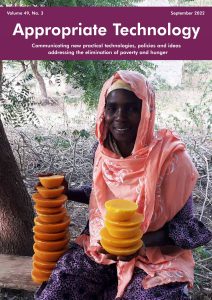
Editor’s note: This article is a reprint of a page that appears in print in Appropriate Technology, Vol 49, No. 3. It is published here with permission as a part of our collaboration with the magazine. For more, please see the magazine’s site: www.appropriate-technology.com.
For most of us, climate change remains a threat to our future and to that of the generations that will follow us, as they face the challenge of caring for this Earth of ours. For the people of Pakistan, however, the impact of climate change is already a deadly reality, measured in loss of life for more than 1000 people since June this year and the destruction of homes and livelihoods for many, many more.
Estimates vary concerning the true extent of the devastation caused by the floods which have swept across the country, with reports of up to 33 million people having been affected over the past four months. Viewed in pure commercial terms, the floods are believed to have cost US$30 billion, although seeking to put a price on such a disaster is surely an insult to those who have lost so much, including family members.
Visiting Pakistan in recent days, USAID Administrator, Samantha Power, spoke of the destruction she’d witnessed, enabling her to gain a firsthand understanding of the rebuilding task which lies ahead. She also made a point of linking the disaster to climate change, and to the role played by the US and other major world powers in causing the problem in the first place. “From the US perspective, we recognise that a country like Pakistan is responsible for a very, very small share of global emissions and that we, the United States, are responsible for a much more substantial share,” she said. “It is those emissions from the world collectively that have given rise to these very extreme climate shocks, which are likely only to recur and intensify.”
Brave words from such an important US official, which I suspect won’t win her many plaudits in certain parts of her homeland. She also pointed out that, while much of Pakistan remains under water, the Horn of Africa is experiencing its fifth failed rainy season. Three in a row has occurred before but never five. We’ve devoted four pages (10-13) to the Pakistan floods in this issue and would urge you to take time to consider what Administrator Power and others have to say on the subject.
Superworm and friends
This issue also contains a reminder of some of the more interesting lifeforms which are happy (I presume) to call the Earth their home. Some are potentially extremely helpful to us, if only in clearing up some of the mess we’ve managed to create in recent decades.
Beetle larvae, commonly known as ‘superworms’, contain several gut enzymes capable of digesting polystyrene, a common plastic which is used in the manufacture of everyday items such as containers and disposable cutlery. Sadly, once we’ve finished with these items, they tend to end up on shorelines around the world. (More on this on page 59.) We also have the latest research update on the battle against the fall armyworm, which, as one of Africa’s most devastating and difficult pests, is definitely not on our potentially helpful list (Pages 48-50).
All of which highlights the importance of knowing what you’re dealing with, which is where the somewhat unusual insect image on this page fits in. Pictured is an Euplectromorpha emeljanovi, captured in all its glory by the International Centre of Insect Physiology and Ecology’s new MacroSolutions Macropod photographic system. The ability to take such a detailed picture is vital in distinguishing between potentially helpful and definitely dangerous insects. There are more images and a fuller explanation on pages 34 and 35.
Find this and other commentary in Appropriate Technology Magazine’s profile on our site.
Appropriate Technology Magazine is a print publication by Research Information Ltd in Burnham, Buckinghamshire (UK). The magazine is a conglomeration of three, the original Appropriate Technology that was first published y Intermediate Technology Publications, International Agricultural Development and Gate Technology.

